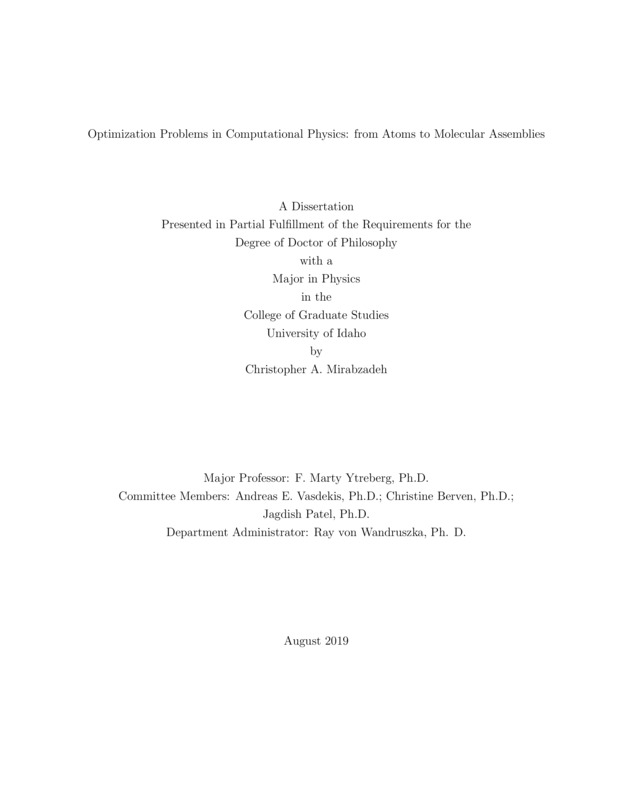Optimization Problems in Computational Physics: from Atoms to Molecular Assemblies
Mirabzadeh, Christopher. (2019-08). Optimization Problems in Computational Physics: from Atoms to Molecular Assemblies. Theses and Dissertations Collection, University of Idaho Library Digital Collections. https://www.lib.uidaho.edu/digital/etd/items/mirabzadeh_idaho_0089e_11590.html
- Title:
- Optimization Problems in Computational Physics: from Atoms to Molecular Assemblies
- Author:
- Mirabzadeh, Christopher
- Date:
- 2019-08
- Keywords:
- Adaptive Integration Finite Element Analysis Molecular Dynamics
- Program:
- Physics
- Subject Category:
- Physics; Biophysics; Computational physics
- Abstract:
-
Computer simulations are an invaluable tool in physics to help understand underlying mechanisms and explore parameter space without the need to perform costly experiments. This dissertation outlines two optimization problems in computational physics. The first is using molecular modeling to estimate the free energy---a fundamental physical quantity. The second is using finite element analysis to design a superconducting magnet system that could be used to efficiently store energy. As a measure of the amount of energy available to do work, the free energy is important for understanding, e.g., how amino acid mutations affect protein-protein interactions or designing new drugs. Here, we present an implementation of the Monte Carlo adaptive integration method (AIM) in the popular molecular dynamics software package, GROMACS. We use AIM to calculate free energies in two model molecular systems and compared these results against a suite of standard methods. We show that AIM converges with less simulation time than standard methods. We have also investigated the use of Halbach magnet arrays in combination with high-temperature superconductors for magnetic levitation of a fly-wheel energy storage system. Halbach arrays were selected because they have properties that are expected to be beneficial for efficient energy storage. To find the optimum orientation of the magnets for the arrays, we used Infolytica Magnet, a finite-element computation software package, to iterate over all permutations of magnet arrays consisting of 3 and 5 magnets in single and double layers. The fields and levitation forces as well as the width of the magnet arrays relative to the width of the superconductor were analyzed. We present our findings for the optimal array of this type and suggest guidelines to increase the levitation force of a superconducting magnetic bearing.
- Description:
- doctoral, Ph.D., Physics -- University of Idaho - College of Graduate Studies, 2019-08
- Major Professor:
- Ytreberg, Frederick M
- Committee:
- Vasdekis, Andreas E; Berven, Christine; Patel, Jagdish
- Defense Date:
- 2019-08
- Identifier:
- Mirabzadeh_idaho_0089E_11590
- Type:
- Text
- Format Original:
- Format:
- application/pdf
- Rights:
- In Copyright - Educational Use Permitted. For more information, please contact University of Idaho Library Special Collections and Archives Department at libspec@uidaho.edu.
- Standardized Rights:
- http://rightsstatements.org/vocab/InC-EDU/1.0/

